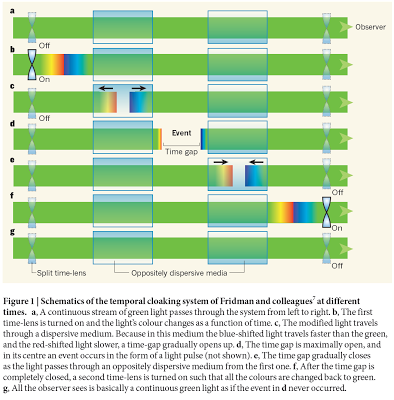By James Van Howe
 From R. Boyd and Z. Shi,"News and Views" Nature, Jan 5, 2012, explaining temporal-cloaking
From R. Boyd and Z. Shi,"News and Views" Nature, Jan 5, 2012, explaining temporal-cloaking
This post originally appeared on Jim’s CLEO Blog and is reproduced with permission from the author.
At Frontiers in Optics 2011 just this last October, Moti Fridman from Alex Gaeta’s group presented work on a the first experimental demonstration of temporal-cloaking using a time-lens system. The work was based upon a theoretical paper from Martin McCall et al in the February issue of the Journal of Optics, and at the beginning of this month, appeared in an in-depth treatment in the January 5, issue of Nature. Besides the usual barrage of bloggers latching onto science-fictionesque results of new research, time-cloaking was also written up in traditional news media such as the Christian Science Monitor.
Temporal-cloaking certainly sounds like something out of Star Trek, but what is it and why is it so great? What makes a temporal cloak truly exciting, and what a majority of the recent articles and posts fail to highlight, is that the temporal-cloak allows cloaking over an infinite section of space albeit for a finite duration of time.
Let’s imagine Harry Potter and his invisibility cloak. If the invisibility cloak is a temporal-cloak, Harry can move as far as he wants to the left-and-right and up-and-down without being seen for duration of the cloaking window. Harry can also move a little bit forward and backward without being seen, but not much or else he will walk out of the cloaking time-window (which is 50 ps for the Gaeta group’s work or about 1.0 cm in fiber). It is crucial that he is in the right place in the axial dimension (forward/backward) since the window occurs at a specific place in space, but he has total freedom in the transverse dimension for the duration of the cloak. Conceivably Harry could pull-off a bank robbery as long as the bank and the vault are inside that particular infinite pancake of cloaking window and within the duration of the window.
Contrast that to a spatial cloak which gives cloaking for an infinite amount of time, but only a finite section of space. If Harry has a spatial invisibility cloak, then he can stand in one spot for as long as he wants without being seen.
Finally, if Harry has a spatio-temporal cloak, conceivably he can maintain invisibility for any duration of time and throughout any volume of space.
The temporal-cloak shown by the Gaeta group is not a practical cloak. If you scrutinize the setup you’ll find that the way that they detect a cloaked event is through lack of nonlinear mixing. A nonlinear signal tells them the event is detected, and no signal tells them that the event is cloaked. You could just turn the power down to get the same result. They also couple into and out of the cloaking window with fiber-couplers between the cloaking apparatus. You can’t send both the signal and the event to be cloaked down the same fiber because if the “event” goes through the same time-lens system as the “signal” the event will appear superposed instead of cloaked. Basically they had to sneak it into the right spot at the right time along a different path of propagation.
However, the point of the work was not to show practical temporal cloaking for masking or encryption, but to show the very odd, very fundamental, and very cool phenomena of creating and tailoring gaps in time. So even if the temporal-cloak won’t be used anytime in the near future for cracking safes, it does bring the optics community closer to a true spatio-temporal invisibility cloak. It might be time to start brushing up on the rules of Quidditch.
Posted: 27 January 2012 by
James Van Howe
| with 0 comments